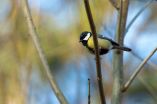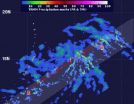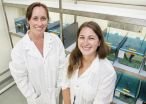(Press-News.org) This news release is available in German.
Animals often differ in their behavioural response to risky situations such as exposure to predators. Researchers from the Max Planck Institute for Ornithology now found in a long-term study on different populations of great tits that risk-taking behaviour correlates with both metabolic rate and ambient temperature. High metabolic rates and low temperatures were associated with high risk-taking behaviour, as in these scenarios birds were more likely to approach potential predators.
The readiness to take a risk is to a great extent influenced by external circumstances. A recent study showed that men living singly are more risk-prone than those living in a steady relationship. Individual differences in risk-taking behaviour are present not only in humans but also in other vertebrates and even in invertebrates such as the Beadlet anemone. However, not only external factors can explain these differences in behaviour, but also the basal metabolic rate of the body. For example, in great tits there are large individual differences in basal metabolic rate are consistent over extended periods of time (e.g. years).
A team of researchers from the Max Planck Institute for Ornithology in Seewiesen now found in a long-term study in great tits a relationship between risk-taking behaviour and metabolic rate. Moreover, they investigated how risk-taking behaviour depends on environmental factors. Within the study period of two years they were able to determine the behaviour and metabolic rate of 184 individual great tits from 12 populations between two lakes in Upper Bavaria, the "Ammersee" and the "Starnberger See". The birds were captured when roosting inside their nest boxes and brought to the lab to measure metabolic rates. The birds were then equipped with passive transponders, so-called "pit-tags", and released back to their territories. There, the researchers installed bird feeders that were fitted with antennas connected to radio frequency identification readers to monitor the movement of great tits. In order to monitor risk-taking behaviour a stuffed model of a sparrowhawk was presented next to the feeders accompanied by playbacks of great tit mobbing calls. With the aid of the transponders, the researchers were able to measure the time that the birds needed to return to the feeder after the disturbance. This measure was then used as a measure for risk-taking behaviour for further analysis.
As a next step the researchers investigated how all these factors were related to each other by means of complex statistical analyses. They first found that the great tits differed in metabolic rate, body mass, and risk-taking behaviour between both study years; in the year when birds had higher metabolic rate, they also showed higher levels of risk-taking behaviour. Additionally, within each year, birds with higher metabolic rates returned to the feeder sooner after being presented with the predator disturbance. Amazingly, ambient temperature also had an influence on overall risk-taking behaviour; birds tended to take more risks when temperatures were lower "This study shows that variation in risk-taking behaviour is linked to differences in energy constraints. Birds facing higher energetic constraints - either because they have a higher metabolic rate or because low ambient temperatures cause them to spend more energy on thermoregulation – are more willing to forage under "risky" conditions, like when a predator has recently been observed in the area," concludes Kimberley Mathot, first author of the study. Possibly birds with a high metabolic rate simply cannot afford to delay feeding because of their higher energetic needs, and thus are more willing to take risks.
INFORMATION:
Original publication
Kimberley J. Mathot, Marion Nicolaus, Yimen G. Araya-Ajoy, Niels J.Dingemanse, Bart Kempenaers
Does metabolic rate predict risk-taking behaviour? A field experiment in a wild passerine bird
Functional Ecology, 29 September 2014
Risky metabolism
Risk-taking behavior depends on metabolic rate and temperature in great tits
2014-09-30
ELSE PRESS RELEASES FROM THIS DATE:
New blood test determines whether you have or are likely to get cancer
2014-09-30
A new research report published in the October 2014 issue of The FASEB Journal may make the early detection of cancer as easy as a simple blood test. This test, called the "lymphocyte genome sensitivity" (LGS) test, could not only detect some cancers earlier than ever before, but it may eliminate the need for some types of biopsies, as well as identify those more likely to develop cancer in the future.
"The test could allow earlier cancer detection, so helping to save peoples' lives," said Diana Anderson, a researcher involved in the work from the School of Life Sciences ...
Tropical Storm Rachel dwarfed by developing system 90E
2014-09-30
Tropical Storm Rachel is spinning down west of Mexico's Baja California, and another tropical low pressure area developing off the coast of southwestern Mexico dwarfs the tropical storm. NOAA's GOES-West satellite showed the size difference between the two tropical low pressure areas.
NOAA's GOES-West satellite captured an image of the Eastern Pacific Ocean on Sept. 30 at 1200 UTC (8 a.m. EDT). In the infrared image, Tropical Storm Rachel appeared small in comparison to the low pressure area called System 90E, coming together hundreds of miles south. As Rachel spins down ...
Virginia Tech researchers discover potential biomarker to detect 'bubble boy' disorder
2014-09-30
Many people recognize "the bubble boy" as an unusual character from a "Seinfeld" episode or a John Travolta movie.
But in reality, a genetic disease called SCID, short for severe combined immunodeficiency, forces patients to breathe filtered air and avoid human contact because their bodies' natural defenses are too weak to fight germs.
Although it affects fewer than 2,000 new births each year worldwide, SCID is a cousin to acquired immune deficiency syndrome triggered by a human immunodeficiency virus — HIV/AIDS.
Now, using a mouse model, Virginia Tech researchers ...
NASA's TRMM satellite sees Tropical Storm Phanfone fragmented
2014-09-30
The bands of thunderstorms wrapping around Tropical Storm Phanfone in the Northwestern Pacific Ocean appeared fragmented to NASA's TRMM satellite.
On Sept. 30, a typhoon watch remains in effect for the far northern Marianas Islands including Pagan and Alamagan. Tropical storm warnings have been cancelled for Tinian and Saipan, but remain in effect for Pagan, Alamagan and surrounding waters. A flash flood watch remains in effect for the island of Saipan. For updated forecasts for these islands, visit the U.S. National Weather Service Office's Guam website: http://www.prh.noaa.gov/guam/cyclone.php.
On ...
A heartbeat away? Hybrid 'patch' could replace transplants
2014-09-30
Because heart cells cannot multiply and cardiac muscles contain few stem cells, heart tissue is unable to repair itself after a heart attack. Now Tel Aviv University researchers are literally setting a new gold standard in cardiac tissue engineering.
Dr. Tal Dvir and his graduate student Michal Shevach of TAU's Department of Biotechnology, Department of Materials Science and Engineering, and Center for Nanoscience and Nanotechnology, have been developing sophisticated micro- and nanotechnological tools — ranging in size from one millionth to one billionth of a meter — ...
In stickleback fish, dads influence offspring behavior and gene expression
2014-09-30
CHAMPAIGN, Ill. — Researchers report that some stickleback fish fathers can have long-term effects on the behavior of their offspring: The most attentive fish dads cause their offspring to behave in a way that makes them less susceptible to predators. These behavioral changes are accompanied by changes in gene expression, the researchers report.
The findings appear in the Proceedings of the Royal Society B: Biological Sciences.
"There is lots of evidence that moms are very important for their offspring," said University of Illinois animal biology professor Alison Bell, ...
How career dreams are born
2014-09-30
COLUMBUS, Ohio – A new study shows just what it takes to convince a person that she is qualified to achieve the career of her dreams.
Researchers found that it's not enough to tell people they have the skills or the grades to make their goal a reality.
Instead, many people need a more vivid and detailed description of just how pursuing their dream career will help make them successful.
This is especially important for people who have the skills and potential to pursue a particular career, but lack the self-confidence, said Patrick Carroll, author of the study and ...
Chemical interactions between silver nanoparticles and thiols: A comparison of mercaptohexanol again
2014-09-30
Silver nanoparticles are well known for their anti-bacteria properties[1-4]. One of the main routes by which they may act as an anti-bacteria agent, is through attaching themselves to the thiol group present on the cellular membrane surface and hence disrupting the membrane's function[5]. Hence, it is crucial to gain a greater understanding of this complex silver-thiol interaction to determine silver nanoparticles' role in biological systems. With thiols, silver nanoparticles have been proposed to form various types of compounds with different structures[6-8]. One of the ...
Gender equality leads to more Olympic medals for men and women
2014-09-30
Gender equality boosts a country's Olympic medal count for both women and men, shows a new study from the University of British Columbia.
Drawing data from the World Economic Forum's 2013 Global Gender Gap Report, researchers compared a country's tendency toward sexual equality with its medal counts from the London 2012 Olympic Games and the Sochi 2014 Olympic Winter Games.
Countries with greater parity – particularly for measures of educational equality – had more women and men reach the podium.
"Our study makes apparent that gender equality has a tendency to lift ...
New learning mechanism for individual nerve cells
2014-09-30
The traditional view is that learning is based on the strengthening or weakening of the contacts between the nerve cells in the brain. However, this has been challenged by new research findings from Lund University in Sweden. These indicate that there is also a third mechanism – a kind of clock function that gives individual nerve cells the ability to time their reactions.
"This means a dramatic increase in the brain's learning capacity. The cells we have studied control the blink reflex, but there are many cells of the same type that control entirely different processes. ...
LAST 30 PRESS RELEASES:
Heart-brain connection: international study reveals the role of the vagus nerve in keeping the heart young
Researchers identify Rb1 as a predictive biomarker for a new therapeutic strategy in some breast cancers
Survey reveals ethical gaps slowing AI adoption in pediatric surgery
Stimulant ADHD medications work differently than thought
AI overestimates how smart people are, according to HSE economists
HSE researchers create genome-wide map of quadruplexes
Scientists boost cell "powerhouses" to burn more calories
Automatic label checking: The missing step in making reliable medical AI
Low daily alcohol intake linked to 50% heightened mouth cancer risk in India
American Meteorological Society announces Rick Spinrad as 2026 President-Elect
Biomass-based carbon capture spotlighted in newly released global climate webinar recording
Illuminating invisible nano pollutants: advanced bioimaging tracks the full journey of emerging nanoscale contaminants in living systems
How does age affect recovery from spinal cord injury?
Novel AI tool offers prognosis for patients with head and neck cancer
Fathers’ microplastic exposure tied to their children’s metabolic problems
Research validates laboratory model for studying high-grade serous ovarian cancer
SIR 2026 delivers transformative breakthroughs in minimally invasive medicine to improve patient care
Stem Cell Reports most downloaded papers of 2025 highlight the breadth and impact of stem cell research
Oxford-led study estimates NHS spends around 3% of its primary and secondary care budget on the health impacts of heat and cold in England
A researcher’s long quest leads to a smart composite breakthrough
Urban wild bees act as “microbial sensors” of city health.
New study finds where you live affects recovery after a hip fracture
Forecasting the impact of fully automated vehicle adoption on US road traffic injuries
Alcohol-related hospitalizations from 2016 to 2022
Semaglutide and hospitalizations in patients with obesity and established cardiovascular disease
Researchers ‘listen in’ to embryo-mother interactions during implantation using a culture system replicating the womb lining
How changing your diet could help save the world
How to make AI truly scalable and reliable for real-time traffic assignment?
Beyond fragmented markets: A new framework for efficient and stable ride-pooling
Can shape priors make road perception more reliable for autonomous driving?
[Press-News.org] Risky metabolismRisk-taking behavior depends on metabolic rate and temperature in great tits





